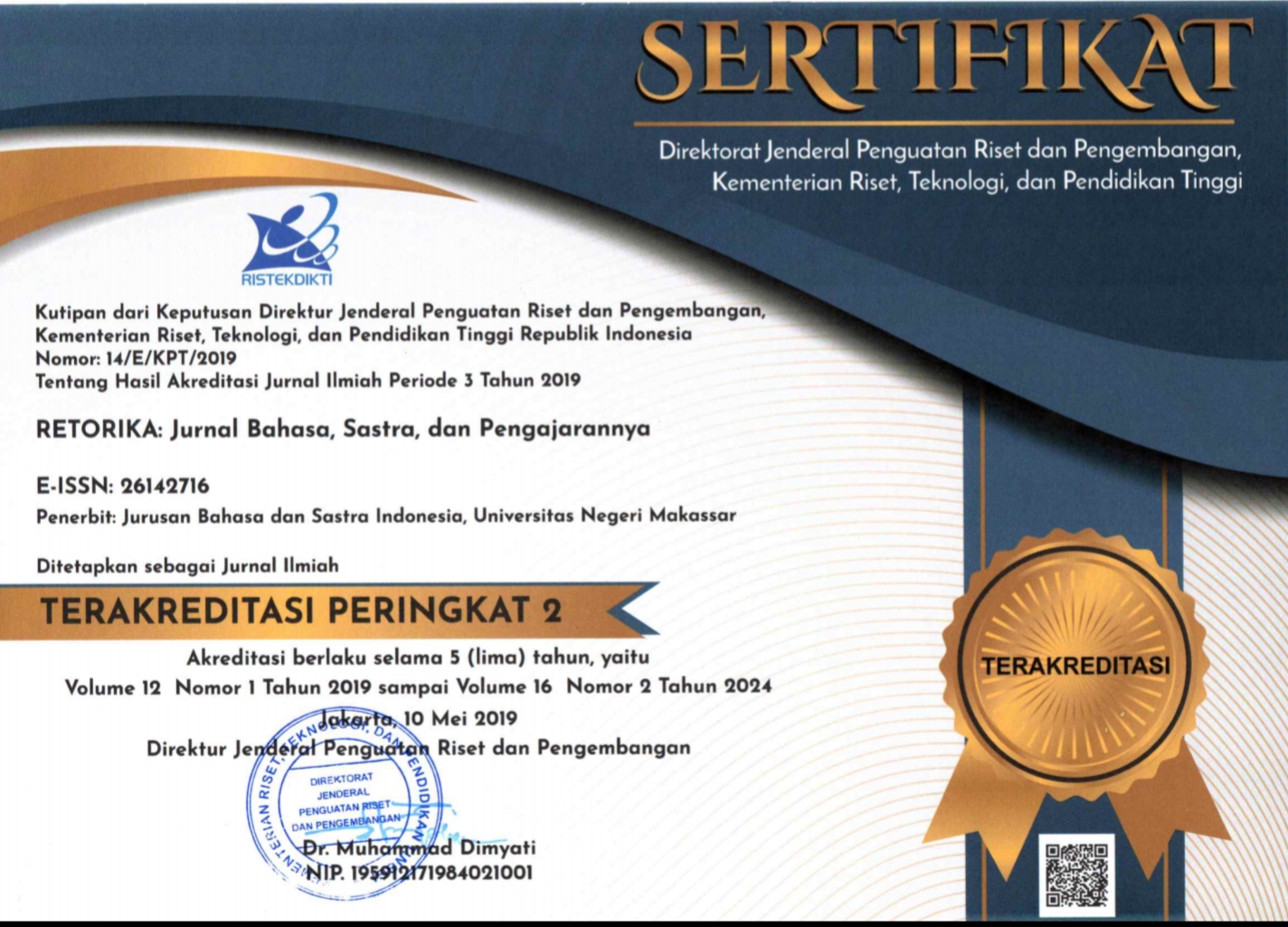TEACHERS’ PARALANGUAGE IN CLASSROOM INTERACTION
(1) State University of Makassar
(2) State University of Makassar
(3) State University of Makassar
(4) State University of Makassar
(*) Corresponding Author
DOI: https://doi.org/10.26858/retorika.v15i1.14127
Abstract
Paralanguage, as a part of non-verbal communication, is believed to have fruitful contribution to the successful teaching and learning process. Therefore, it is crucial to explore the features of teachers’ paralanguage in EFL classroom interactions and the function of those paralanguage features in classroom interaction. Under the design of qualitative research, this study employed classroom observation and recording. The subject is one English class with one teacher and 31 students in one Senior High School in Makassar, Indonesia. To analyze data, steps of analysis which included data collection, data reduction, data display and conclusion (drawing or verifying) adopted from Miles, Huberman, and Saldana (2014) were employed. The result of data analysis showed that the teacher applied some features of paralanguage in classroom interaction in the forms of (1) voice qualities that consist of pitch (the highness and lowness of tone), rhythm (smooth rhythm), and rate (slow rate or tempo); and (2) vocalizations that include vocal characterizers (laughing) and vocal segregate (sound “ee”). This study also found that the use of teacher’s paralanguage in teaching was (1) to accent, (2) to complement, (3) to contradict, (4) to regulate, and (5) to repeat. Findings from this study can become a reference for teachers in creating effective classroom interaction. The use of paralanguage by the teacher in the class as one aspect of non-verbal communication is needed as one way to create effective classroom interaction.
Keywords
Full Text:
PDFReferences
Acosta, A.C. (2014). The importance of paralinguistic features when teaching English to beginner learners. Pareira: University of Pereira
Adler, R. B., & Rodman, G. R. (2006). Understanding human communication (9th ed). New York: Oxford University Press.
Alfatihi, M. (2006). The role of communication in Beginners’ EFL classrooms. Sidi Mohamed Benabdellah University.
Budacia, L. C. G. (2010). The firm’s patrimony–an international approach. Quarterly Journal, 311.
DeVito, J. A. (1988). The nonverbal communication workbook. Waveland PR Inc.
DeVito, J. A. (2013). The interpersonal communication book (13th ed). Boston: Pearson.
Khalifa, E. M., & Faddal, H. (2017). Impacts of using paralanguage on teaching and learning English language to convey effective meaning. Studies in English Language Teaching, 5(2), 295. https://doi.org/10.22158/selt.v5n2p295
Miles, M. B., Huberman, A. M., & Saldana, J. (2014). Qualitative data analysis : an expanded sourcebook,(3rd ed). Thousand Oaks : Sage Publications.
Muchemwa, S. (2013). Use of nonverbal communication in the classroom as a way of enhancing classroom teaching: A case study of Solusi high school, Zimbabwe. Procedia-Social and Behavioral Sciences, 103, 1279–1287. https://doi.org/10.1016/j.sbspro.2013.10.457
Negi, J. S. (2009). The role of teachers’ non-verbal communication in ELT classroom. Journal of NELTA, 101-110.
Omotayo, A. A. (2017). Non-verbal communication approach to inculcating moral values in tertiary institutions. English Language, Literature & Culture, 2(2), 12. https://doi.org/10.11648/j.ellc.20170202.11
Poyatos, F. (2002). Nonverbal communication across disciplines: Paralanguage, kinesics, silence, personal and environmental interaction (Vol. 2). John Benjamins Publishing.
Qiang, K. (2013). Paralanguage. Canadian Social Science, 9(6), 222.
Sabas, J. J. O., & Torres, N. G. (2017). Non-verbal communication in language teaching to facilitate students’ understanding and promote oral interaction. Revista Digital Palabra, 4(1), 22–37.
Sutthinaraphan, K., & Wasanasomsithi, P. (2017). A study of English communication strategy use of undergraduate students majoring in science. The New English Teacher, 11(2), 98.
Zani, R. M., Ahmad, S. S., Merican, F. M. I., & Ahmad, I. N. (2017). The relationship between lecturers’ paralanguage and students’ satisfaction in university technology Mara, Kedah, Malaysia. Gading Journal for the Social Sciences, 15(01).
Article Metrics
Abstract view : 572 times | PDF view : 70 timesRefbacks
- There are currently no refbacks.
Copyright (c) 2022 Murni Mahmud

This work is licensed under a Creative Commons Attribution-NonCommercial 4.0 International License.
Published by:
Department of Indonesian Language, Faculty of Languages and Literature, Universitas Negeri Makassar in cooperate with Asosiasi Dosen Bahasa dan Sastra Indonesia (ADOBSI) and Ikatan Program Studi Pendidikan Bahasa dan Sastra Indonesia (IKAPROBSI).
Address: Department of Indonesian Language Office, DG Building Second Floor, UNM Parangtambung, Daeng Tata Raya Street, Makassar, South Sulawesi, Indonesia
 Email: retorika@unm.ac.id
Email: retorika@unm.ac.id

RETORIKA: Jurnal Bahasa, Sastra,dan Pengajarannya is licensed under a Creative Commons Attribution-NonCommercial 4.0 International License.
















